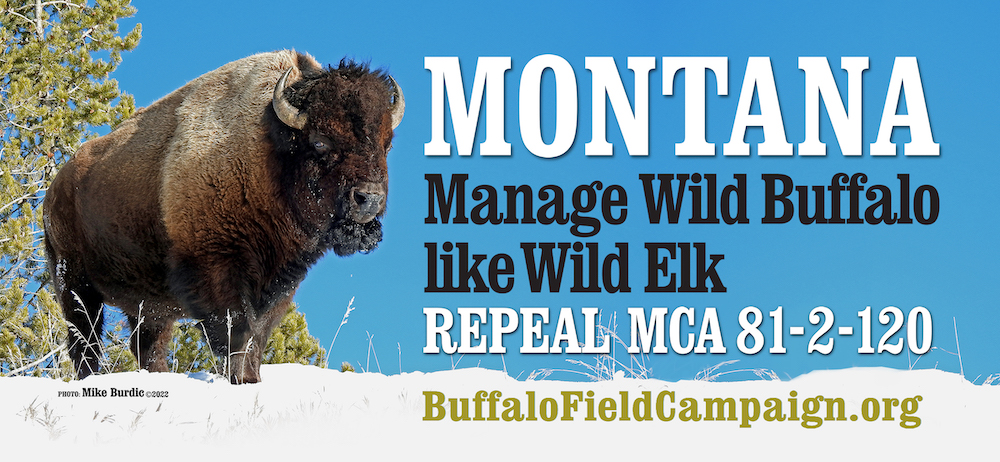YOUR VOICE WILL HELP REPEAL MCA 81-2-120
Why should Montanan’s support repealing MCA 81-2-120?
- Because MCA 81-2-120 is destroying wild buffalo, and failing to fulfill Montana’s public trust responsibilities “to create and maintain conditions under which humans and nature can coexist” on behalf of “each generation as trustee of the environment for succeeding generations.” (Montana Code Ann. § 75-1-103).
- Because MCA 81-2-120 absurdly puts the Montana Department of Livestock in charge of Montana’s only wild buffalo! Do you agree that this is crazy?!
Under MCA 81-2-120: Montana Dept. of Livestock agents have trespassed onto private land to harass wild buffalo without landowner permission, and in many cases, over the objections of and against landowner wishes. It required an executive order from Gov. Steve Bullock in 2014 to restrain this taxpayer-funded agency from trespassing on private land to harass wild buffalo. (1)
Under MCA 81-2-120: for Montana's hunt, wild buffalo cannot be hunted without permission from the State Veterinarian and the Montana Dept. of Livestock. (2)
From 2004-2022, of 171,448 applicants, 1,119 hunters drew wild buffalo tags generating at least $2,032,945 in revenue for Montana. (3)
Under MCA 81-2-120, from 1995-2010, the Montana Dept. of Livestock shot or “captured for slaughter” 1,482 wild buffalo migrating into Hebgen basin, a habitat comprised primarily of National Forest land. (4)
Under MCA 81-2-120: proceeds from auctioning wild buffalo killed by the Montana Dept. of Livestock go into a special account to fund the livestock agency. (5)
Under MCA 81-2-120: in the spring, Dept. of Livestock agents haze or harass wild buffalo in their habitat while mother buffalo are calving. These costly and unnecessary government operations harm wild buffalo, degrade wildlife habitat, and make a mockery of science-based wildlife management. (6)
Under MCA 81-2-120: buffalo once belonging to future generations have been and still are being taken for quarantine from the wild in Yellowstone National Park and privatized for commercial benefit. Montana’s promise of buffalo being conserved as wildlife continues to be broken. (7)
Under MCA 81-2-120: wild buffalo roam less than 0.4% of the habitat in Montana. (8) There is no year-round population of wild buffalo in Montana, and no provision in MCA 81-2-120 to sustain wild buffalo—a wild, native species that Montana biologists recognize as vulnerable to “extinction or extirpation in the state.” (9)
Why not run a citizen initiative and repeal MCA 81-2-120?
Because Montana state legislators would simply undo what the majority of Montanans would do at the ballot box: vote to manage wild buffalo as a wildlife species with habitat available to sustain the migratory species in the wild. Everyone concerned about wild buffalo must persuade elected officials repealing MCA 81-2-120 is the right thing to do.
How did MCA 81-2-120 become law?
In the early 1990s, Montana cattle ranchers were in an uproar over the migration of buffalo into habitat in Montana beyond Yellowstone National Park's borders.
Using the fear of brucellosis disease and loss of the state’s brucellosis-free status, cattle ranchers successfully manipulated the Montana legislature into passing MCA 81-2-120. The new law displaced Fish, Wildlife & Parks’ authority over the public’s only wild buffalo population, putting primary authority for the migratory species in the hands of the Montana Dept. of Livestock and the State Veterinarian.
Who pays for enforcing MCA 81-2-120?
From 2000-2016, the U.S. Dept. of Agriculture-APHIS funneled $10,381,534 in taxpayer funds to the Montana Dept. of Livestock to enforce MCA 81-2-120. (10)
From 2000-2016, Montana’s contribution to enforce MCA 81-2-120 totaled $238,772. (10)
It is the American taxpayer who is paying the Montana Dept. of Livestock to capture, slaughter, harass, haze, vaccinate, quarantine, and shoot wild buffalo.
How are the Interagency Bison Management Plan and MCA 81-2-120 related?
Shortly after MCA 81-2-120 became law in 1995, Governor Marc Racicot used the state statute to sue Yellowstone National Park to stop the migration of wild buffalo beyond park boundaries into Montana. The suit resulted in a settlement calling for the creation of an Interagency Bison Management Plan to placate Montana’s cattle industry.
Under the Interagency Bison Management Plan – the Montana “governor-approved plan” MCA 81-2-120 calls for – millions of taxpayer dollars are spent destroying thousands of wild buffalo inside Yellowstone National Park, and in Montana, on National Forest, state, and private lands. *
Another 15- to 20-year iteration of the Interagency Bison Management Plan is being prepared to fund the same costly, harmful, and destructive livestock practices embodied in MCA 81-2-120.(11) Buffalo Field Campaign has proposed a common sense alternative to the government to simply and effectively manage wild buffalo like wild elk.
* According to the U.S. Government Accountability Office, for 2007, the last fiscal year reporting, the government spent $2,927,500 taxpayer dollars to implement the Interagency Bison Management Plan. From 2002-2007, the government spent $15,932,288 taxpayer dollars to implement its plan.
Will repealing MCA 81-2-120 harm Montana’s cattle industry?
It will NOT harm Montana's cattle industry! In Montana, cattle are being managed under a U.S. Dept. of Agriculture-APHIS (Animal and Plant Health Inspection Service) approved and taxpayer-subsidized plan in Designated Surveillance Areas. Ranchers are reimbursed $9.50 to $14 per head for vaccinating cattle. (12)
Despite a few cases of brucellosis transmission reportedly from wild elk to cattle, and zero (EVER!) from wild buffalo to cattle in 100 years, Montana's Designated Surveillance Area rules have protected the state's brucellosis free status AND DIMINISHED THE THREAT OF STATE SANCTIONS. (13)
According to the Montana Dept. of Livestock, the new USDA-approved rules save cattle ranchers $5.5 to $11.5 million dollars annually – $110,000,000 to $230,000,000 since the rules went into effect in 2010.. (14)
The unfounded threats and discredited fears of brucellosis raised by cattle ranchers do not justify Montana Dept. of Livestock management of Montana’s wild buffalo.
What are the outcomes of repealing MCA 81-2-120?
The Montana Fish, Wildlife & Parks would manage wild buffalo as a native wildlife species.
The Montana Dept. of Livestock would regulate livestock.
What would managing wild buffalo like wild elk in Montana look like?
Wild buffalo would be managed by wildlife biologists, and be based on sustainable populations in available habitat. This is the same science-based standard currently and successfully used to manage wild elk, deer, and antelope in Montana.
Montana is blessed with tens of millions of acres of habitat on National Forests, wildlife refuges, and other public lands suitable for a migratory species like the wild buffalo. They could simply roam free, in peace and harming no one.
America’s indigenous peoples and tribal nations with cultural connections, spiritual ties, and treaty rights to wild buffalo can take pride in providing a respectful, lasting legacy for their relatives and future generations.
Montanans supporting wild buffalo as a native species can take pride in restoring the “monarch of the prairies”: the wild buffalo, an enduring American symbol of the freedom to roam.
Sources
1. Governor Steve Bullock, Bison Hazing, May 22, 2014. (Download the PDF)
2. Mont. Code. Ann. § 81-2-120(1)(c). “The live wild buffalo or wild bison may be taken through limited public hunts pursuant to 87-2-730 when authorized by the state veterinarian and the department.”
3. myfwp.mt.gov/fwpPub/drawingStatistics; Montana Fish, Wildlife & Parks Bison Harvest Data. Draw and tag revenue extrapolated from FWP data. Download the PDF. (Download the PDF)
4. P.J. White et al., Management of Yellowstone bison and brucellosis transmission risk – Implications for conservation and restoration. Biological Conservation, 144: 1322-1334 (Feb. 9, 2011).
5. Mont. Code Ann. § 81-2-120(3)(b). “In disposing of the carcass, the department may sell a wild buffalo or wild bison carcass to help defray expenses of the department. If the carcass is sold in this manner, the department shall deposit any revenue derived from the sale of the wild buffalo or wild bison carcass to the state special revenue fund to the credit of the department.”
6. Buffalo Field Campaign video. Buffalo Nightmare: 3 days Straight of Helicopter Hazing, May 16, 2013. Online: https://www.youtube.com/watch?v=QxY89VYqtQQ. See also Buffalo Field Campaign video. Highway 287 Haze, May 11, 2015. Online: https://www.youtube.com/watch?v=Wy1Kqr8EB-I.
7. Montana Fish, Wildlife & Parks, Montana Dept. of Livestock, and Turner Enterprises Inc. Memorandum of Understanding, February 16, 2010. Montana Fish, Wildlife & Parks and the Assiniboine and Sioux Tribes of the Fort Peck Reservation. Memorandum of Understanding, Quarantine Feasibility Study Bison, March 16, 2012. Turner Enterprises Inc. acquired 75% of the buffalo offspring and 68 buffalo were shipped to the Fort Peck and Fort Belknap reservations.
8. Montana Fish, Wildlife & Parks and Montana Dept. of Livestock. Year-round Habitat for Yellowstone Bison, Draft Joint Environmental Assessment, July 2013.
9. Adams, S.M. and A.R. Dood. 2011. Background Information on Issues of Concern for Montana: Plains Bison Ecology, Management, and Conservation. Montana Fish, Wildlife and Parks, Bozeman, Montana.
10. Montana Dept. of Livestock and U.S. Dept. of Agriculture Animal and Plant Health Inspection Service. Cooperative Agreements 2004-2016, Bison Operations and GYIBC History of Expenditures FFY01-FFY07, Project Proposal/Work Plan and Budget for Managing Cattle Health (Brucellosis) for FY 2012-2013. Montana Dept. of Livestock FY 2000 Bison Fiscal Year Report, October 25, 2000. U.S. Government Accountability Office, YELLOWSTONE BISON, Interagency Plan and Agencies’ Management Need Improvement to Better Address Bison-Cattle Brucellosis Controversy, Mar. 7, 2008. Online: https://www.gao.gov/products/A81263
11. U.S. National Park Service, Environmental Impact Statement for a Management Plan for Yellowstone–Area Bison, 80 Fed. Reg. 13603 (March 16, 2015). (Download the PDF)
12. Montana Dept. of Livestock. Brucellosis Testing / Adult Vaccinating Invoice (SV-15) and Producer Brucellosis Testing Reimbursement Form (SV-16), Fiscal Year 2011. See also U.S. Dept. of Agriculture Animal and Plant Health Inspection Service, USDA Revises Testing and Certification Requirements for the National Brucellosis Program, December 27, 2010. Montana Dept. of Livestock. Department of Livestock Announces New Brucellosis Rules, (Oct. 11, 2018). Online: http://liv.mt.gov/Portals/146/news/2018/MDOL%20rule%20adoption%20pr.pdf?ver=2018-10-11-151640-970
13. Yellowstone Center for Resources. 2012. A Risk Analysis of Brucella abortus Transmission Among Bison, Elk, and Cattle in the Northern Greater Yellowstone Area. Technical Report for the National Park Service, October 2010. Mammoth Hot Springs, Wyoming, YCR-2012-02.
The risk assessment of brucellosis transmission among buffalo, elk, and cattle in the northern range of the greater Yellowstone ecosystem found the exposure risk from buffalo to cattle was miniscule 0.0–0.3% compared to elk to cattle 99.7–100% of the total risk.
14. Montana Dept. of Livestock. Economic Analysis: MDOL’s DSA Worth Millions to Cattle Producers, State, March 4, 2011. (Download the PDF)











